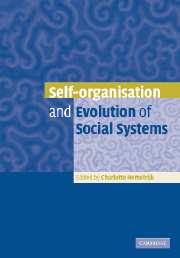Book contents
- Frontmatter
- Contents
- List of contributors
- Preface
- Introduction
- 1 From unicellular to multicellular organisation in the social amoeba Dictyostelium discoideum
- 2 Optimality of communication in self-organised social behaviour
- 3 The interplay of intracolonial genotypic variance and self-organisation of dominance hierarchies in honeybees
- 4 Traffic rules of fish schools: a review of agent-based approaches
- 5 A process-oriented approach to the social behaviour of primates
- 6 Order and noise in primate societies
- 7 Self-organisation in language
- 8 Dictatorship effect of majority rule in voting in hierarchical systems
- 9 Natural selection and complex systems: a complex interaction
- 10 Interlocking of self-organisation and evolution
- Index
- References
2 - Optimality of communication in self-organised social behaviour
Published online by Cambridge University Press: 07 December 2009
- Frontmatter
- Contents
- List of contributors
- Preface
- Introduction
- 1 From unicellular to multicellular organisation in the social amoeba Dictyostelium discoideum
- 2 Optimality of communication in self-organised social behaviour
- 3 The interplay of intracolonial genotypic variance and self-organisation of dominance hierarchies in honeybees
- 4 Traffic rules of fish schools: a review of agent-based approaches
- 5 A process-oriented approach to the social behaviour of primates
- 6 Order and noise in primate societies
- 7 Self-organisation in language
- 8 Dictatorship effect of majority rule in voting in hierarchical systems
- 9 Natural selection and complex systems: a complex interaction
- 10 Interlocking of self-organisation and evolution
- Index
- References
Summary
Introduction
In animal societies, collective decisions and patterns emerge through self-organised processes, from a variety of interactions among individuals. The rules specifying these interactions are executed using only local information, that is, without reference to the global pattern. Thus collective decisions can be made that, at the individual level, require only limited cognitive abilities and partial knowledge of the environment (Camazine et al., 2001; Hemelrijk, 2002). Simple behavioural rules lead to behavioural flexibility of the society depending on its characteristics (e.g. demography, starvation and kinship) and on its environment (e.g. food distribution and presence of competitors).
Most self-organised decisions and patterns arise as a result of a competition between different sources of information that are amplified through different positive feedbacks. In contrast, negative feedbacks often arise ‘automatically’ as a result of the system's constraints (e.g. limits on the supply of food, the food reserve and the number of available workers). Amplifying communication is a characteristic of group-living animals (Deneubourg and Goss, 1989; Parrish and Keshet-Edelstein, 1999). One common type of such communication is recruitment to multiple food sources in social arthropods, but also in vertebrates and many others groups. The nature of interactions implied in these phenomena depends on the species and can involve chemical communication and/or physical contacts (Hölldobler and Wilson, 1991; Fitzgerald, 1995; Seeley, 1995; Costa and Louque, 2001; Ruf et al., 2001). Many parameters may influence the patterns of food exploitation as well as foraging efficiency.
- Type
- Chapter
- Information
- Publisher: Cambridge University PressPrint publication year: 2005
References
- 3
- Cited by



